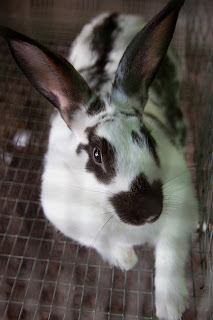Rabbit Production Makes a Difference in Haiti
Rabbit producers in Haiti have made significant gains over
the past 2 ½ years of the Farmer to
Farmer Small Animal project, thanks to the support of Farmer to Farmer volunteers and the ongoing training and follow-up
provided by Makouti Agro Enterprise. Partners of the Americas has been tracking
the progress of individuals and groups receiving FTF support and based on a
recent review, we have found very encouraging results which show the impact the
project has had on Haitian farmers who are determined to improve their
livelihoods.
Our study compared baseline data, collected primarily in
2008 and 2009, against data collected in early 2011 for 99 producers and
producer groups (hosts). We found that there was a 142% increase in the number
of rabbits each host owned, with an average increase per host of nearly 19
rabbits. One producer from Grand Riviere du Nord started with only 4 rabbits in
late 2008 and was managing 96 rabbits by early 2011. There was a 185% increase in offspring, although mortality
rates of young continues to fluctuate as new producers come on board and learn
the ropes of caring for these animals. On
average, hosts increased their monthly
income from rabbit sales by US$19.55, and one host increased his monthly
income from rabbit sales from $0 to $125 per month!
What does it mean to a small-scale rabbit producer in Haiti?
Consider the story of Paul, from a mountain town in Haiti near the Dominican
Republic border, who has 6 people in his family. On his small plot of land he
grew coffee and beans, and in February 2009 he reported making 20,000 Haitian
Gourdes (US$500) net income per year from his farming activities. That month he
received 3 adult rabbits and started a FTF training program in rabbit
production. Two years later in February of 2011, he had 18 adult rabbits with
60 offspring. He now earns 100,000 Haitian Gourdes (US$2,500) per year in net
income from selling rabbits, has 8 clients in the Dominican Republic and Haiti,
and has hired an employee. He takes notes of all his sales, and he also makes
compost and plants trees.
Although an average increase in monthly income of $19.55 seems
negligible to an average American family, for a Haitian family this increase
can mean the difference in putting food on the table or sending your children
to school. According to the World Bank, “school fees are also prohibitively
expensive [to most Haitian families]—an estimated US$70 to US$80 per child each
year in a country with a per capita GDP of US$480. In many cases, parents
simply cannot afford to send their children to school.” In early 2011, 74% of rabbit producers assisted by
Makouti Agro Enterprise and the Farmer to
Farmer Program report they can now
afford the fees to send all of their children to school with money made
from rabbit sales. Imagine the broader difference that can be made in Haiti
when more families are managing small agro-enterprises, putting healthier food on
the table, and sending all their children to school!



.png)

Comments
Post a Comment